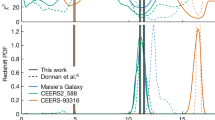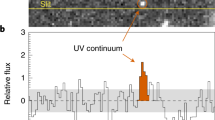Abstract
Of several dozen galaxies observed spectroscopically that are candidates for having a redshift (z) in excess of seven, only five have had their redshifts confirmed via Lyman α emission, at z = 7.008, 7.045, 7.109, 7.213 and 7.215 (refs 1, 2, 3, 4). The small fraction of confirmed galaxies may indicate that the neutral fraction in the intergalactic medium rises quickly at z > 6.5, given that Lyman α is resonantly scattered by neutral gas3,5,6,7,8. The small samples and limited depth of previous observations, however, makes these conclusions tentative. Here we report a deep near-infrared spectroscopic survey of 43 photometrically-selected galaxies with z > 6.5. We detect a near-infrared emission line from only a single galaxy, confirming that some process is making Lyman α difficult to detect. The detected emission line at a wavelength of 1.0343 micrometres is likely to be Lyman α emission, placing this galaxy at a redshift z = 7.51, an epoch 700 million years after the Big Bang. This galaxy’s colours are consistent with significant metal content, implying that galaxies become enriched rapidly. We calculate a surprisingly high star-formation rate of about 330 solar masses per year, which is more than a factor of 100 greater than that seen in the Milky Way. Such a galaxy is unexpected in a survey of our size9, suggesting that the early Universe may harbour a larger number of intense sites of star formation than expected.
This is a preview of subscription content, access via your institution
Access options
Subscribe to this journal
Receive 51 print issues and online access
$199.00 per year
only $3.90 per issue
Buy this article
- Purchase on Springer Link
- Instant access to full article PDF
Prices may be subject to local taxes which are calculated during checkout



Similar content being viewed by others
References
Vanzella, E. et al. Spectroscopic confirmation of two Lyman break galaxies at redshift beyond 7. Astrophys. J. 730, L35 (2011)
Schenker, M. A. et al. Keck spectroscopy of faint 3 < z < 8 Lyman break galaxies: evidence for a declining fraction of emission line sources in the redshift range 6 < z < 8. Astrophys. J. 744, 179 (2012)
Ono, Y. et al. Spectroscopic confirmation of three z-dropout galaxies at z = 6.844–7.213: demographics of Lyα emission in z ∼ 7 galaxies. Astrophys. J. 744, 83 (2012)
Shibuya, T. et al. The first systematic survey for Lyα emitters at z = 7.3 with red-sensitive Subaru/Suprime-Cam. Astrophys. J. 752, 114 (2012)
Kashikawa, N. et al. The end of the reionization epoch probed by Lyα emitters at z = 6.5 in the Subaru deep field. Astrophys. J. 648, 7–22 (2006)
Iye, M. et al. A galaxy at a redshift z = 6.96. Nature 443, 186–188 (2006)
Ouchi, M. et al. Statistics of 207 Lyα emitters at a redshift near 7: constraints on reionization and galaxy formation models. Astrophys. J. 723, 869–894 (2010)
Pentericci, L. et al. Spectroscopic confirmation of z ∼ 7 Lyman break galaxies: probing the earliest galaxies and the epoch of reionization. Astrophys. J. 743, 132 (2011)
Smit, R. et al. The star formation rate function for redshift z ∼ 4–7 galaxies: evidence for a uniform buildup of star-forming galaxies during the first 3 Gyr of cosmic time. Astrophys. J. 756, 14 (2012)
Grogin, N. A. et al. CANDELS: The Cosmic Assembly Near-infrared Deep Extragalactic Legacy Survey. Astrophys. J. 197 (Supp.). 35 (2011)
Koekemoer, A. M. et al. CANDELS: The Cosmic Assembly Near-infrared Deep Extragalactic Legacy Survey – The Hubble Space Telescope observations, imaging data products, and mosaics. Astrophys. J. 197 (Supp.). 36 (2011)
McLean, I. S. et al. MOSFIRE, the multi-object spectrometer for infra-red exploration at the Keck Observatory. Proc. SPIE 8446, J84460–1-15 (2012)
Finkelstein, S. L. et al. On the stellar populations and evolution of star-forming galaxies at 6.3 ≤ z ≤ 8.6. Astrophys. J. 719, 1250–1273 (2010)
McLure, R. J. et al. Galaxies at z = 6–9 from the WFC3/IR imaging of the Hubble Ultra Deep Field. Mon. Not. R. Astron. Soc. 403, 960–983 (2010)
Finkelstein, S. L. et al. CANDELS: The evolution of galaxy rest-frame ultraviolet colors from z = 8 to 4. Astrophys. J. 756, 164 (2012)
McLure, R. J. et al. A new multifield determination of the galaxy luminosity function at z = 7–9 incorporating the 2012 Hubble Ultra-Deep Field imaging. Mon. Not. R. Astron. Soc. 432, 2696–2716 (2013)
Stark, D. P. et al. Keck spectroscopy of 3 < z < 7 faint Lyman break galaxies: the importance of nebular emission in understanding the specific star formation rate and stellar mass density. Astrophys. J. 763, 129 (2013)
Riechers, D. A. et al. A dust-obscured massive maximum-starburst galaxy at a redshift of 6.34. Nature 496, 329–333 (2013)
Stark, D. P., Ellis, R. S. & Ouchi, M. Keck spectroscopy of faint 3>z>7 Lyman break galaxies: a high fraction of line emitters at redshift six. Astrophys. J. 728, L2 (2011)
Fan, X. et al. Constraining the evolution of the ionizing background and the epoch of reionization with z∼6 quasars. II. A sample of 19 quasars. Astron. J. 132, 117–136 (2006)
Bolton, J. S. et al. How neutral is the intergalactic medium surrounding the redshift z = 7.085 quasar ULAS J1120+0641? Mon. Not. R. Astron. Soc. 416, L70–L74 (2011)
Finkelstein, S. L. et al. CANDELS: the contribution of the observed galaxy population to cosmic reionization. Astrophys. J. 758, 93 (2012)
Dekel, A. et al. Toy models for galaxy formation versus simulations. Mon. Not. R. Astron. Soc. 435, 999–1019 (2013)
Kennicutt, R. C. & Evans, N. J. Star formation in the Milky Way and nearby galaxies. Annu. Rev. Astron. Astrophys. 50, 531–608 (2012)
Krumholz, M. R. & Dekel, A. Metallicity-dependent quenching of star formation at high redshift in small galaxies. Astrophys. J. 753, 16 (2012)
Riechers, D. A. et al. A dust-obscured massive maximum-starburst galaxy at a redshift of 6.34. Nature 496, 329–333 (2013)
Kennicutt, R. C., Jr Star formation in galaxies along the Hubble sequence. Annu. Rev. Astron. Astrophys. 36, 189–231 (1998)
Acknowledgements
We thank M. Dijkstra, J. Rhoads and S. Malhotra for conversations, as well as N. Konidaris and C. Steidel for assistance with the MOSFIRE data reduction pipeline. We also thank our Keck Support Astronomer G. Wirth for assistance during our observing run. S.L.F. acknowledges support from the University of Texas at Austin, the McDonald Observatory and NASA through a NASA Keck PI Data Award, administered by the NASA Exoplanet Science Institute. Data presented here were obtained at the W. M. Keck Observatory from telescope time allocated to NASA through the agency’s scientific partnership with the California Institute of Technology and the University of California. The Observatory was made possible by the financial support of the W. M. Keck Foundation. We recognize and acknowledge the cultural role and reverence that the summit of Mauna Kea has within the indigenous Hawaiian community. This work is also based in part on observations made with the NASA/ESA Hubble Space Telescope, obtained at the Space Telescope Science Institute, which is operated by the Association of Universities for Research in Astronomy, Inc., under NASA contract NAS 5-26555, as well as the Spitzer Space Telescope, which is operated by the Jet Propulsion Laboratory, California Institute of Technology under a contract with NASA.
Author information
Authors and Affiliations
Contributions
S.L.F. wrote the text, obtained and reduced the data and led the initial observing proposal. C.P. and M.D. assisted with the analysis of the data. M.S. and V.T. assisted with the observation planning and implementation. K.D.F. performed the Spitzer/IRAC photometry. A.M.K. was responsible for the reduction of the optical and NIR imaging data used to select the sample. G.G.F., M.L.N.A. and S.P.W. obtained and reduced the mid-infrared data. B.J.W. provided grism spectroscopic information. B.M., H.C.F., M.G., N.R., A.D., A.F., N.A.G., J.-S.H., D.K. and M.R. have contributed in their roles as members of the CANDELS and S-CANDELS teams, and assisted with the planning and interpretation of the observations.
Corresponding author
Ethics declarations
Competing interests
The authors declare no competing financial interests.
Supplementary information
Supplementary Information
This file contains Supplementary Text, Supplementary References, Supplementary Tables 1-3 and Supplementary Figures 1-5. (PDF 690 kb)
Rights and permissions
About this article
Cite this article
Finkelstein, S., Papovich, C., Dickinson, M. et al. A galaxy rapidly forming stars 700 million years after the Big Bang at redshift 7.51. Nature 502, 524–527 (2013). https://doi.org/10.1038/nature12657
Received:
Accepted:
Published:
Issue Date:
DOI: https://doi.org/10.1038/nature12657
This article is cited by
-
The nature of an ultra-faint galaxy in the cosmic dark ages seen with JWST
Nature (2023)
-
The high-redshift Universe with Spitzer
Nature Astronomy (2020)
-
Evidence for GN-z11 as a luminous galaxy at redshift 10.957
Nature Astronomy (2020)
-
Spectroscopic confirmation of an ultra-faint galaxy at the epoch of reionization
Nature Astronomy (2017)
-
The formation of submillimetre-bright galaxies from gas infall over a billion years
Nature (2015)
Comments
By submitting a comment you agree to abide by our Terms and Community Guidelines. If you find something abusive or that does not comply with our terms or guidelines please flag it as inappropriate.



